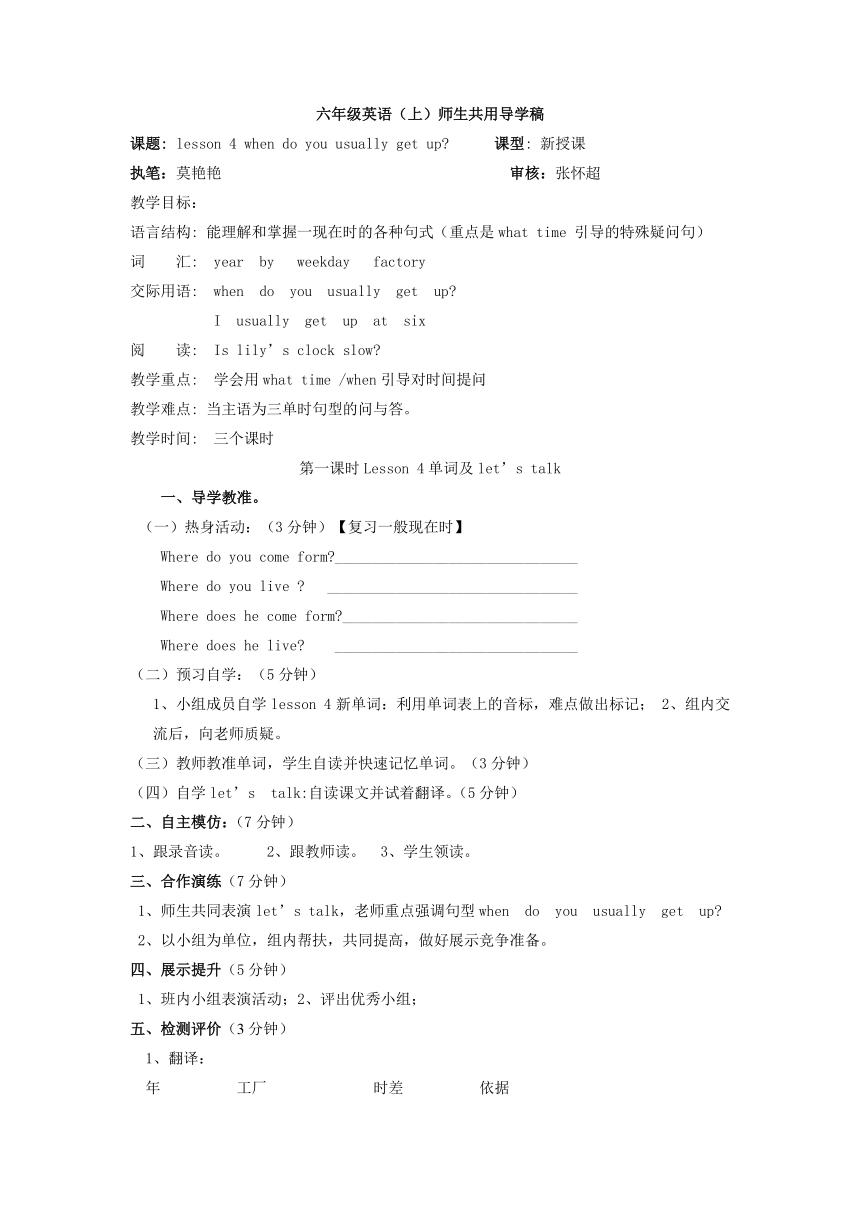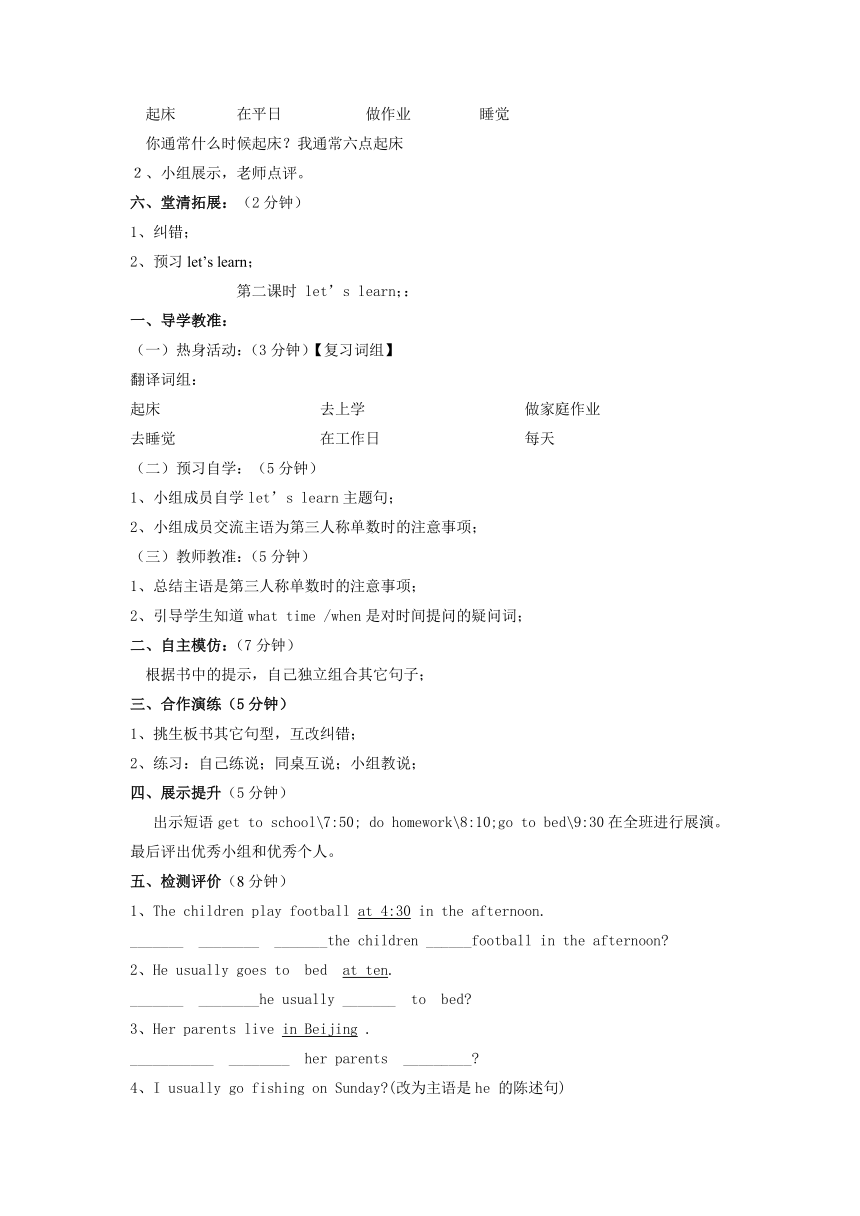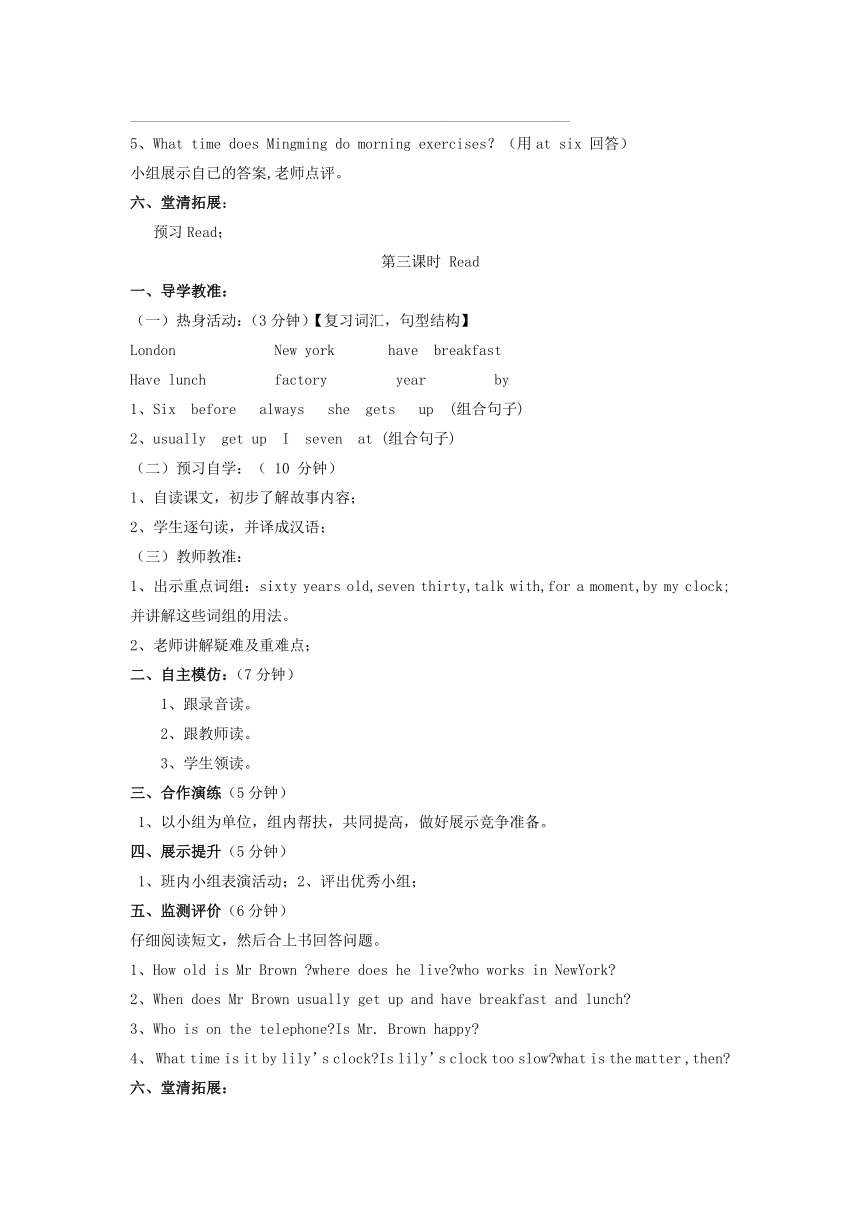四年级英语(上)4、5课导学稿
文档属性
| 名称 | 四年级英语(上)4、5课导学稿 |  | |
| 格式 | zip | ||
| 文件大小 | 18.2KB | ||
| 资源类型 | 教案 | ||
| 版本资源 | 外研版(三年级起点) | ||
| 科目 | 英语 | ||
| 更新时间 | 2013-09-29 08:08:32 | ||
图片预览



文档简介
六年级英语(上)师生共用导学稿
课题: lesson 4 when do you usually get up 课型: 新授课
执笔:莫艳艳 审核:张怀超
教学目标:
语言结构: 能理解和掌握一现在时的各种句式(重点是what time 引导的特殊疑问句)
词 汇: year by weekday factory
交际用语: when do you usually get up
I usually get up at six
阅 读: Is lily’s clock slow
教学重点: 学会用what time /when引导对时间提问
教学难点: 当主语为三单时句型的问与答。
教学时间: 三个课时
第一课时Lesson 4单词及let’s talk
一、导学教准。
(一)热身活动:(3分钟)【复习一般现在时】
Where do you come form ________________________________
Where do you live _________________________________
Where does he come form _______________________________
Where does he live ________________________________
(二)预习自学:(5分钟)
1、小组成员自学lesson 4新单词:利用单词表上的音标,难点做出标记; 2、组内交流后,向老师质疑。
(三)教师教准单词,学生自读并快速记忆单词。(3分钟)
(四)自学let’s talk:自读课文并试着翻译。(5分钟)
二、自主模仿:(7分钟)
1、跟录音读。 2、跟教师读。 3、学生领读。
三、合作演练(7分钟)
1、师生共同表演let’s talk,老师重点强调句型when do you usually get up
2、以小组为单位,组内帮扶,共同提高,做好展示竞争准备。
四、展示提升(5分钟)
1、班内小组表演活动;2、评出优秀小组;
五、检测评价(3分钟)
1、翻译:
年 工厂 时差 依据
起床 在平日 做作业 睡觉
你通常什么时候起床?我通常六点起床
2、小组展示,老师点评。
六、堂清拓展:(2分钟)
1、纠错;
2、预习let’s learn;
第二课时 let’s learn;:
一、导学教准:
(一)热身活动:(3分钟)【复习词组】
翻译词组:
起床 去上学 做家庭作业
去睡觉 在工作日 每天
(二)预习自学:(5分钟)
1、小组成员自学let’s learn主题句;
2、小组成员交流主语为第三人称单数时的注意事项;
(三)教师教准:(5分钟)
1、总结主语是第三人称单数时的注意事项;
2、引导学生知道what time /when是对时间提问的疑问词;
二、自主模仿:(7分钟)
根据书中的提示,自己独立组合其它句子;
三、合作演练(5分钟)
1、挑生板书其它句型,互改纠错;
2、练习:自己练说;同桌互说;小组教说;
四、展示提升(5分钟)
出示短语get to school\7:50; do homework\8:10;go to bed\9:30在全班进行展演。最后评出优秀小组和优秀个人。
五、检测评价(8分钟)
1、The children play football at 4:30 in the afternoon.
_______ ________ _______the children ______football in the afternoon
2、He usually goes to bed at ten.
_______ ________he usually _______ to bed
3、Her parents live in Beijing .
___________ ________ her parents _________
4、I usually go fishing on Sunday (改为主语是he 的陈述句)
__________________________________________________________
5、What time does Mingming do morning exercises?(用at six 回答)
小组展示自已的答案,老师点评。
六、堂清拓展:
预习Read;
第三课时 Read
一、导学教准:
(一)热身活动:(3分钟)【复习词汇,句型结构】
London New york have breakfast
Have lunch factory year by
1、Six before always she gets up (组合句子)
2、usually get up I seven at (组合句子)
(二)预习自学:( 10 分钟)
1、自读课文,初步了解故事内容;
2、学生逐句读,并译成汉语;
(三)教师教准:
1、出示重点词组:sixty years old,seven thirty,talk with,for a moment,by my clock;并讲解这些词组的用法。
2、老师讲解疑难及重难点;
二、自主模仿:(7分钟)
1、跟录音读。
2、跟教师读。
3、学生领读。
三、合作演练(5分钟)
1、以小组为单位,组内帮扶,共同提高,做好展示竞争准备。
四、展示提升(5分钟)
1、班内小组表演活动;2、评出优秀小组;
五、监测评价(6分钟)
仔细阅读短文,然后合上书回答问题。
1、How old is Mr Brown where does he live who works in NewYork
2、When does Mr Brown usually get up and have breakfast and lunch
3、Who is on the telephone Is Mr. Brown happy
4、 What time is it by lily’s clock Is lily’s clock too slow what is the matter ,then
六、堂清拓展:
用括号中所给单词的适当形式填空
1. Lily is_________ (Mr. Brown ) daughter .she ___________(live ) in NewYork.
2. she ________(do) homework at 7:30 every day.
3. what are you ________(do) I __________(watch) TV.
4. This is ______(he ) book .Please give it to _______(he).
5. whose are these _________(box) They are ______(we)
六年级上册英语师生共用导学稿
课题: Lesson 5 How do you go to school 课型: 新授课 执笔:吴欢欢
教学内容和要求:
1、能听懂、会说、会认读、会拼写far、last、window。
2、能听懂、会说、会认读travel,train,worried,safe,agree,ant,at last,by bike,by bus(car),by train(plane…)
3、能听懂和会认Paris。
4、熟练掌握和运用一般现在时的各种句式(重点是how引导的特殊疑问句)。
5、能听懂、会说——How do you usually go to school
——I usually go to school by bike。
——How does she usually go to school
——She usually goes to school by bus 。
第一课时 Let’s talk
一、导学教准
(一)、热身活动:(3分钟)
1、在班级中搜集同学们如何让上学,做成卡片,引出所要学习的对话情景,学生初步感知对话情景。
(二)、预习自学:(5分钟)
1、小组成员自学新单词:依据单词表,难点做出标记;
(三)、教师用正确的发音,读法及语态示范,学生快速记忆单词。(3分钟)
(四)、自学课文,师生互动,练习主题句型的运用。(3分钟)
二、自主模仿(7分钟)
1、教师将本课对话按课本所示分成两段,给每段配挂图(或教师自己画的简笔画);
2、逐段放录音,学生跟说,同时教师在每段图下给出关键词;
3、学生两人一组根据关键词练习复述,先分段练习,再连起来复述;
4、学生能熟练复述后,教师可找几组学生站起来复述,自主模仿对话内容。
三、合作演练(7分钟)
1、全班内分角色对对话内容分角色练习。
2、小组内练习对话。
3、小组内结合对子用自己的方式表演对话。
四、展示提升(5分钟)
1、小组展示:组内对子展示自己表演的对话,老师做好记录。
2、个人展示:本节所学习的单词及主要句型在黑板上或对话中展示,组长做好本组记录。
五、检测评价(3分钟)
1、口语检测:检测学生本课句子How do you usually go to school
——I usually go to school by bike。
——How does she usually go to school
——She usually goes to school by bus 。
是否会读会用。
2、英汉连线
Far last window
窗户 远的 最后
六、堂清拓展(2分钟)
1、根据课文内容填空。
(1)Do you often go to school at
(2)I near the school.
(3) do you usually go to school
(4)She lives from the school.
(5)She usually goes to school to school or .
第二课时 Let’s learn
一、导学教准(10分钟)
1、复习单词:教师给出下列词组,学生说出汉语意思:by bus , by car , by bike , by train , go to school , go home .
2、导入Let’s learn:让学生根据实际情况回答教师提出的问题。
How do you usually go home , Ling Ming
I usually go home on foot .
How does Ling Ming usually go home
He usually goes home on foot..
二、自主模仿(3分钟)
1、教师准备好一些卡片,如:by bike , by bus , on foot , by train , by car , by plane等。让学生模仿教师的问题练习用这些词组练习。
三、合作演练(8分钟)
1、先由教师手拿卡片(by bike)问“How do you usually go home ”学生集体答“I usually go home by bike .” 集体练熟后再同桌互相问答。
2、小组内练习。
四、展示提升(8分钟)
1、小组展示:小组到前面互相问答,直到全部练熟为止。
2、个人展示:个人也可扩大操练范围增加一些词组如go to work 然后再问。
五、检测评价(5分钟)
1、口语检测:检测学生本课句子How do you usually go to school
——I usually go to school by bike。
——How does she usually go to school
——She usually goes to school by bus 。
是否会读会用。
2、全班内检测是否会回答答语,简单的提问。
六、堂清拓展(6分钟)
根据要求完成句子。
1、I usually go to school by bike。(对划线部分提问)
2、How does he go home
3、She goes to school to Canada by plane. (对划线部分提问)
第三课时 Read for fun、Let’s sing:
一、导学教准(7分钟)
1、教师创设情境引导学生初读课文内容,自己画出词组及不理解的句子。
二、自主模仿(5分钟)
学生自主学习重点词组:教师将下列词组写在黑板上,领读并说出中文意思:by plane , by train , by ship , go back , every three months, this time , ride in a plane , agree to, get on , begin to ,be afraid ,look out of , look like ,on the ground . 教师可适当讲解这些词组的用法。
三、合作演练(8分钟)
1、在小组内交流解决,并画出自己解决不了的词组及句子。
2、在全班内交流本组仍未解决的词组及句子。
3、教师将本课Read for fun的挂图(或教师自画是我简笔画)按先后顺序挂在黑板上,放录音,学生边看图边听,初步感知故事内容;
逐图放录音,学生进一步感知故事内容;
逐图逐句放录音,学生跟说,并译成汉语。
3)在学生比较熟练的复述之后,教师可以找学生个别复述,每人两到三段。
四、展示提升(5分钟)
1、逐图放录音,学生跟说,同时教师在每幅图下给出关键词;
2、学生逐图依据关键词练习复述;
3、教师叫个别学生站起来分段复述,每人一段;
五、检测评价(7分钟)
要求学生能熟读课文并根据课文内容回答问题即可,问题如下:
Where does Helen work Where does she come from Where does her father and mother live
Does she like travelling by plane How does she always go home Does she sometimes go by ship
Where is Bruce from What does he have
Who does Bruce ask to take his plane Does Helen agree to go with him
Is Helen afraid to take the plane Does she close her eyes ?
When does she open her eyes and look out of the window Can she see some people Are they still on the ground
六、堂清拓展(8分钟)
1、Listen and circle:学生根据听录音,在图片下的“Yes” 和“No。”中选择,所听内容与图片一致的选择“Yes.”不一致的选“No.”
(1)、I come from America.
(2)、Yingying usually gets up at six
(3)、Lele does morning exercises every day.
(4)、Tom often gets to school by train.
(5)、She often goes to bed at 9;30.
(6)、I usually have rice for supper.
2、单词检测:将下列单词与相应的汉语意思连线。
Travel 远的
Train 窗户
Worried 旅行
safe 安全的
last 火车
agree 蚂蚁
window 担心的
ant 同意
far 最后
课题: lesson 4 when do you usually get up 课型: 新授课
执笔:莫艳艳 审核:张怀超
教学目标:
语言结构: 能理解和掌握一现在时的各种句式(重点是what time 引导的特殊疑问句)
词 汇: year by weekday factory
交际用语: when do you usually get up
I usually get up at six
阅 读: Is lily’s clock slow
教学重点: 学会用what time /when引导对时间提问
教学难点: 当主语为三单时句型的问与答。
教学时间: 三个课时
第一课时Lesson 4单词及let’s talk
一、导学教准。
(一)热身活动:(3分钟)【复习一般现在时】
Where do you come form ________________________________
Where do you live _________________________________
Where does he come form _______________________________
Where does he live ________________________________
(二)预习自学:(5分钟)
1、小组成员自学lesson 4新单词:利用单词表上的音标,难点做出标记; 2、组内交流后,向老师质疑。
(三)教师教准单词,学生自读并快速记忆单词。(3分钟)
(四)自学let’s talk:自读课文并试着翻译。(5分钟)
二、自主模仿:(7分钟)
1、跟录音读。 2、跟教师读。 3、学生领读。
三、合作演练(7分钟)
1、师生共同表演let’s talk,老师重点强调句型when do you usually get up
2、以小组为单位,组内帮扶,共同提高,做好展示竞争准备。
四、展示提升(5分钟)
1、班内小组表演活动;2、评出优秀小组;
五、检测评价(3分钟)
1、翻译:
年 工厂 时差 依据
起床 在平日 做作业 睡觉
你通常什么时候起床?我通常六点起床
2、小组展示,老师点评。
六、堂清拓展:(2分钟)
1、纠错;
2、预习let’s learn;
第二课时 let’s learn;:
一、导学教准:
(一)热身活动:(3分钟)【复习词组】
翻译词组:
起床 去上学 做家庭作业
去睡觉 在工作日 每天
(二)预习自学:(5分钟)
1、小组成员自学let’s learn主题句;
2、小组成员交流主语为第三人称单数时的注意事项;
(三)教师教准:(5分钟)
1、总结主语是第三人称单数时的注意事项;
2、引导学生知道what time /when是对时间提问的疑问词;
二、自主模仿:(7分钟)
根据书中的提示,自己独立组合其它句子;
三、合作演练(5分钟)
1、挑生板书其它句型,互改纠错;
2、练习:自己练说;同桌互说;小组教说;
四、展示提升(5分钟)
出示短语get to school\7:50; do homework\8:10;go to bed\9:30在全班进行展演。最后评出优秀小组和优秀个人。
五、检测评价(8分钟)
1、The children play football at 4:30 in the afternoon.
_______ ________ _______the children ______football in the afternoon
2、He usually goes to bed at ten.
_______ ________he usually _______ to bed
3、Her parents live in Beijing .
___________ ________ her parents _________
4、I usually go fishing on Sunday (改为主语是he 的陈述句)
__________________________________________________________
5、What time does Mingming do morning exercises?(用at six 回答)
小组展示自已的答案,老师点评。
六、堂清拓展:
预习Read;
第三课时 Read
一、导学教准:
(一)热身活动:(3分钟)【复习词汇,句型结构】
London New york have breakfast
Have lunch factory year by
1、Six before always she gets up (组合句子)
2、usually get up I seven at (组合句子)
(二)预习自学:( 10 分钟)
1、自读课文,初步了解故事内容;
2、学生逐句读,并译成汉语;
(三)教师教准:
1、出示重点词组:sixty years old,seven thirty,talk with,for a moment,by my clock;并讲解这些词组的用法。
2、老师讲解疑难及重难点;
二、自主模仿:(7分钟)
1、跟录音读。
2、跟教师读。
3、学生领读。
三、合作演练(5分钟)
1、以小组为单位,组内帮扶,共同提高,做好展示竞争准备。
四、展示提升(5分钟)
1、班内小组表演活动;2、评出优秀小组;
五、监测评价(6分钟)
仔细阅读短文,然后合上书回答问题。
1、How old is Mr Brown where does he live who works in NewYork
2、When does Mr Brown usually get up and have breakfast and lunch
3、Who is on the telephone Is Mr. Brown happy
4、 What time is it by lily’s clock Is lily’s clock too slow what is the matter ,then
六、堂清拓展:
用括号中所给单词的适当形式填空
1. Lily is_________ (Mr. Brown ) daughter .she ___________(live ) in NewYork.
2. she ________(do) homework at 7:30 every day.
3. what are you ________(do) I __________(watch) TV.
4. This is ______(he ) book .Please give it to _______(he).
5. whose are these _________(box) They are ______(we)
六年级上册英语师生共用导学稿
课题: Lesson 5 How do you go to school 课型: 新授课 执笔:吴欢欢
教学内容和要求:
1、能听懂、会说、会认读、会拼写far、last、window。
2、能听懂、会说、会认读travel,train,worried,safe,agree,ant,at last,by bike,by bus(car),by train(plane…)
3、能听懂和会认Paris。
4、熟练掌握和运用一般现在时的各种句式(重点是how引导的特殊疑问句)。
5、能听懂、会说——How do you usually go to school
——I usually go to school by bike。
——How does she usually go to school
——She usually goes to school by bus 。
第一课时 Let’s talk
一、导学教准
(一)、热身活动:(3分钟)
1、在班级中搜集同学们如何让上学,做成卡片,引出所要学习的对话情景,学生初步感知对话情景。
(二)、预习自学:(5分钟)
1、小组成员自学新单词:依据单词表,难点做出标记;
(三)、教师用正确的发音,读法及语态示范,学生快速记忆单词。(3分钟)
(四)、自学课文,师生互动,练习主题句型的运用。(3分钟)
二、自主模仿(7分钟)
1、教师将本课对话按课本所示分成两段,给每段配挂图(或教师自己画的简笔画);
2、逐段放录音,学生跟说,同时教师在每段图下给出关键词;
3、学生两人一组根据关键词练习复述,先分段练习,再连起来复述;
4、学生能熟练复述后,教师可找几组学生站起来复述,自主模仿对话内容。
三、合作演练(7分钟)
1、全班内分角色对对话内容分角色练习。
2、小组内练习对话。
3、小组内结合对子用自己的方式表演对话。
四、展示提升(5分钟)
1、小组展示:组内对子展示自己表演的对话,老师做好记录。
2、个人展示:本节所学习的单词及主要句型在黑板上或对话中展示,组长做好本组记录。
五、检测评价(3分钟)
1、口语检测:检测学生本课句子How do you usually go to school
——I usually go to school by bike。
——How does she usually go to school
——She usually goes to school by bus 。
是否会读会用。
2、英汉连线
Far last window
窗户 远的 最后
六、堂清拓展(2分钟)
1、根据课文内容填空。
(1)Do you often go to school at
(2)I near the school.
(3) do you usually go to school
(4)She lives from the school.
(5)She usually goes to school to school or .
第二课时 Let’s learn
一、导学教准(10分钟)
1、复习单词:教师给出下列词组,学生说出汉语意思:by bus , by car , by bike , by train , go to school , go home .
2、导入Let’s learn:让学生根据实际情况回答教师提出的问题。
How do you usually go home , Ling Ming
I usually go home on foot .
How does Ling Ming usually go home
He usually goes home on foot..
二、自主模仿(3分钟)
1、教师准备好一些卡片,如:by bike , by bus , on foot , by train , by car , by plane等。让学生模仿教师的问题练习用这些词组练习。
三、合作演练(8分钟)
1、先由教师手拿卡片(by bike)问“How do you usually go home ”学生集体答“I usually go home by bike .” 集体练熟后再同桌互相问答。
2、小组内练习。
四、展示提升(8分钟)
1、小组展示:小组到前面互相问答,直到全部练熟为止。
2、个人展示:个人也可扩大操练范围增加一些词组如go to work 然后再问。
五、检测评价(5分钟)
1、口语检测:检测学生本课句子How do you usually go to school
——I usually go to school by bike。
——How does she usually go to school
——She usually goes to school by bus 。
是否会读会用。
2、全班内检测是否会回答答语,简单的提问。
六、堂清拓展(6分钟)
根据要求完成句子。
1、I usually go to school by bike。(对划线部分提问)
2、How does he go home
3、She goes to school to Canada by plane. (对划线部分提问)
第三课时 Read for fun、Let’s sing:
一、导学教准(7分钟)
1、教师创设情境引导学生初读课文内容,自己画出词组及不理解的句子。
二、自主模仿(5分钟)
学生自主学习重点词组:教师将下列词组写在黑板上,领读并说出中文意思:by plane , by train , by ship , go back , every three months, this time , ride in a plane , agree to, get on , begin to ,be afraid ,look out of , look like ,on the ground . 教师可适当讲解这些词组的用法。
三、合作演练(8分钟)
1、在小组内交流解决,并画出自己解决不了的词组及句子。
2、在全班内交流本组仍未解决的词组及句子。
3、教师将本课Read for fun的挂图(或教师自画是我简笔画)按先后顺序挂在黑板上,放录音,学生边看图边听,初步感知故事内容;
逐图放录音,学生进一步感知故事内容;
逐图逐句放录音,学生跟说,并译成汉语。
3)在学生比较熟练的复述之后,教师可以找学生个别复述,每人两到三段。
四、展示提升(5分钟)
1、逐图放录音,学生跟说,同时教师在每幅图下给出关键词;
2、学生逐图依据关键词练习复述;
3、教师叫个别学生站起来分段复述,每人一段;
五、检测评价(7分钟)
要求学生能熟读课文并根据课文内容回答问题即可,问题如下:
Where does Helen work Where does she come from Where does her father and mother live
Does she like travelling by plane How does she always go home Does she sometimes go by ship
Where is Bruce from What does he have
Who does Bruce ask to take his plane Does Helen agree to go with him
Is Helen afraid to take the plane Does she close her eyes ?
When does she open her eyes and look out of the window Can she see some people Are they still on the ground
六、堂清拓展(8分钟)
1、Listen and circle:学生根据听录音,在图片下的“Yes” 和“No。”中选择,所听内容与图片一致的选择“Yes.”不一致的选“No.”
(1)、I come from America.
(2)、Yingying usually gets up at six
(3)、Lele does morning exercises every day.
(4)、Tom often gets to school by train.
(5)、She often goes to bed at 9;30.
(6)、I usually have rice for supper.
2、单词检测:将下列单词与相应的汉语意思连线。
Travel 远的
Train 窗户
Worried 旅行
safe 安全的
last 火车
agree 蚂蚁
window 担心的
ant 同意
far 最后
同课章节目录
- Module 1
- Unit 1 It's more than twenty thousand kilometers l
- Unit 2 It's in the west.
- Module 2
- Unit 1 There's Chinese dancing.
- Unit 2 There are lots of beautiful lakes in China.
- Module 3
- Unit 1 Collecting stamps is my hobby.
- Unit 2 What's your hobby?
- Module 4
- Unit 1 Thanksgiving is my favourite festival.
- Unit 2 Our favourite festival is the Spring Festiv
- Module 5
- Unit 1 Can you be my Chinese pen friend?
- Unit 2 I can speak French.
- Module 6
- Unit 1 You've got a letter from New York.
- Unit 2 I've got a stamp from China.
- Module 7
- Unit 1 I don't believe it.
- Unit 2 Pandas love bamboo.
- Module 8
- Unit 1 Do you often play with dolls?
- Unit 2 I often go swimming.
- Module 9
- Unit 1 Do you want to visit the UN building?
- Unit 2 I want to go to Shanghai.
- Review Module
- Unit 1
- Unit 2
- Module 10
- Unit 1 Don't talk in the library.
- Unit 2 Go straight on!
